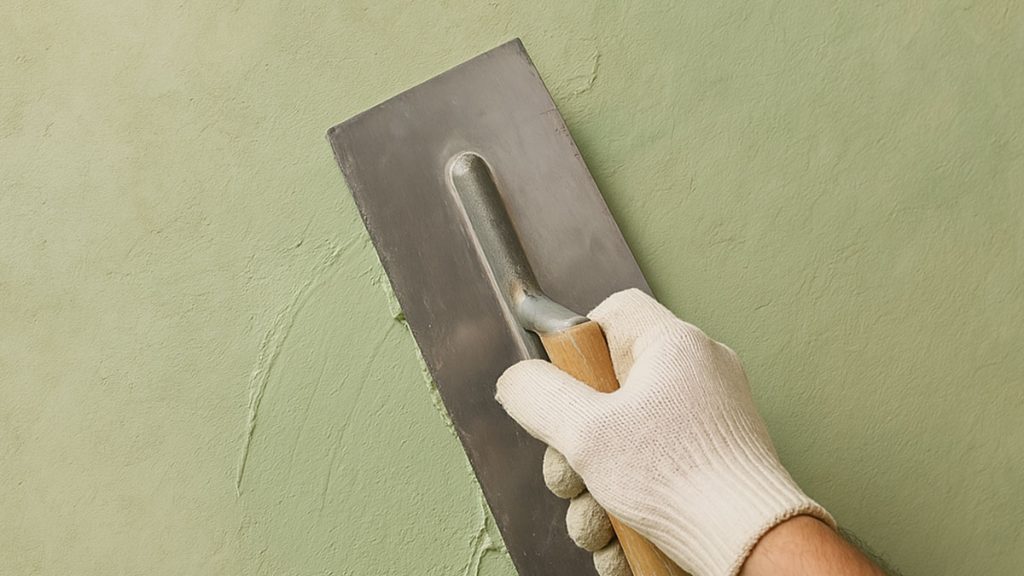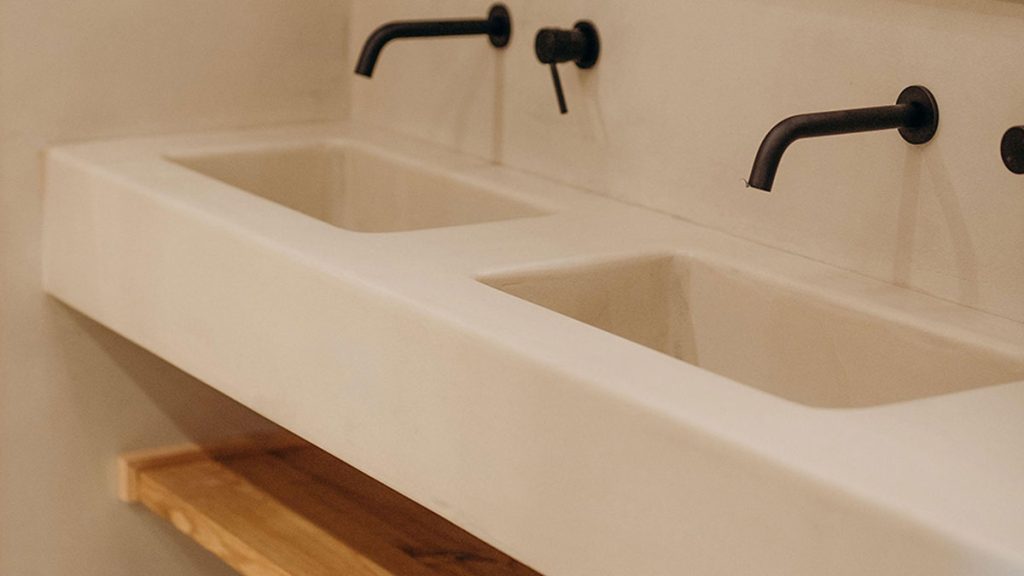¿Puede un material de construcción centenario superar a las alternativas modernas en durabilidad y sostenibilidad? El revoque de cal, una opción consagrada en la construcción, sigue cautivando a constructores y propietarios por igual con su notable longevidad y sus versátiles aplicaciones. Esta guía se adentra en el mundo del revoque de cal, explorando su durabilidad en comparación con otras opciones como Terrazzo Granitech.
El enlucido de cal tiene una vida útil impresionante, que a menudo dura varias décadas cuando se aplica correctamente y se mantiene adecuadamente. Su perdurable popularidad se debe a una combinación única de durabilidad, transpirabilidad y adaptabilidad a diversos estilos arquitectónicos. Desde restauraciones históricas hasta construcciones ecológicas de vanguardia, el yeso de cal demuestra su valía como material de construcción fiable y sostenible.
Al explorar las complejidades del enlucido de cal, descubriremos los secretos de su longevidad y examinaremos cómo influyen en su rendimiento factores como la calidad de la aplicación, las condiciones ambientales y las prácticas de mantenimiento. También compararemos el enyesado de cal con las alternativas modernas, proporcionándole información que le ayudará a tomar decisiones fundamentadas para su próximo proyecto de construcción o renovación.
Índice
Principales conclusiones
- El enlucido de cal puede durar varias décadas con una aplicación y un mantenimiento adecuados.
- La durabilidad del enlucido de cal depende de la calidad de la aplicación, el entorno y el mantenimiento.
- Las inspecciones periódicas son cruciales para identificar el desgaste, las grietas o el deterioro.
- El mantenimiento proactivo prolonga significativamente la vida útil del enlucido de cal
- El revoque de cal ofrece una excelente transpirabilidad y adaptabilidad a diversos estilos arquitectónicos
- Comparar el enlucido de cal con las alternativas modernas ayuda a tomar decisiones de construcción con conocimiento de causa.
Composición y propiedades del enlucido de cal
El enlucido de cal existe desde hace miles de años. Se ha utilizado en muchos edificios famosos, como la Gran Muralla China y estructuras aztecas. Su uso duradero se debe a su mezcla especial y a sus ventajas.
Componentes y materiales básicos
Los principales componentes del enlucido de cal son arena, agua y cal hidratada. Antiguamente, se añadía pelo de caballo para aumentar la resistencia. Hoy en día, podemos utilizar cenizas volantes para obtener mejores resultados. La forma en que se mezclan estas partes cambia la resistencia del enyesado y su duración.
Propiedades químicas y proceso de curado
El enlucido de cal se endurece por reacción con la humedad y el CO2. Cuando está húmedo, es muy alcalino. A medida que se seca, su nivel de pH disminuye. Tarda unos cinco días en curar completamente, más que el enyesado de cemento. El enlucido de cal hidráulica puede fraguar bajo el agua, por lo que es ideal para paredes exteriores.
Tipos de cal utilizados en el enlucido
Existen diferentes tipos de enlucido de cal, cada uno con sus propias características:
- Enlucido de cal hidratada: Conocido por ser fácil de trabajar
- Enlucido de cal viva: Popular en trabajos de restauración
- Enlucido de cal hidráulica: Viene en grados débil, moderado o fuerte.
- Enlucido de cal y cemento: Una mezcla de cal tradicional y cemento para mayor resistencia.
| Tipo de yeso | Tiempo de ajuste | Resistencia (Newtons) | Mejor uso |
| Cal no hidráulica | 5 días | 2-5 | Paredes interiores |
| Cal hidráulica | 3-4 días | 2-5 | Superficies exteriores |
| Cal-cemento | 1-2 días | 5-7 | Zonas de alta humedad |
| Cemento Portland | 1-2 días | 25-35 | Construcción moderna |
Durabilidad del enlucido de cal y factores de rendimiento
El enlucido de cal ha sido un acabado de paredes tradicional durante siglos. Es conocido por su durabilidad, gracias a sus propiedades únicas. A diferencia del enyesado de cemento, el enlucido de cal permite el paso de la humedad sin dañarlo.
Esta capacidad ayuda a prevenir el moho y la humedad, manteniendo limpio el aire interior. El uso de la cal en la construcción se remonta a la antigüedad, con importantes mejoras por parte de los romanos en el año 79 d.C.
Las investigaciones demuestran que la resistencia del enlucido de cal aumenta con determinadas mezclas. Por ejemplo, la adición de cal aérea, arena y polvo de ladrillo reduce la contracción y aumenta la resistencia.
El enlucido de cal puede durar más que las opciones modernas si se aplica correctamente. Tiene una capa de rayado, una capa marrón y una capa de acabado para conseguir una superficie resistente. Su flexibilidad también significa que no se agrieta tan fácilmente como otros acabados.
El rendimiento del enlucido de cal depende de cómo se aplique y del entorno. Mantener la humedad bajo control durante el curado es clave para una buena adherencia. Aunque es menos probable que se agriete que el cemento, necesita manos expertas para obtener los mejores resultados.
Métodos de aplicación tradicionales frente a modernos
El enlucido de cal se ha utilizado durante siglos en paredes exteriores y en el interior de los edificios. Sus métodos de aplicación han cambiado, mezclando técnicas antiguas con otras nuevas, a menudo junto con modernas alternativas a la pintura a la cal que ofrecen una estética similar con una aplicación más sencilla.
Técnicas de aplicación históricas
Los artesanos de antaño mezclaban cal, arena y agua en una proporción de 1:3. Aplicaban la primera capa, o capa raspada, a 5-7 mm. La segunda capa, o capa marrón, tenía un espesor de 8-10 mm.
Con este método, utilizado a menudo con lath y yeso, se conseguían acabados duraderos. Estos acabados han durado muchos años.
Prácticas contemporáneas de instalación
Hoy en día, la aplicación del enlucido de cal mantiene los principios básicos, pero añade nuevas herramientas. El enlucido de cal hidráulico fragua más rápido, especialmente en lugares húmedos. La capa base tiene ahora al menos 20 mm de espesor en 2-3 capas para combatir la humedad.
Incluso con los nuevos métodos, la habilidad artesanal sigue siendo clave para obtener los mejores resultados.
Requisitos de preparación de la superficie
Conseguir la superficie adecuada es vital para evitar daños en el yeso. Tanto los métodos antiguos como los nuevos necesitan una superficie limpia, estable y ligeramente húmeda. Las paredes exteriores utilizan arena gruesa para dar resistencia, mientras que las interiores utilizan arena más fina para dar suavidad.
La mejor temperatura para aplicar el yeso es entre 5-25°C. Así se garantiza que se cure correctamente.
Análisis de costes y valor a largo plazo
El enlucido de cal puede costar más al principio, pero es ecológico y dura mucho. Es ideal para albañilería y manejar la humedad, lo que lo hace versátil. Es perfecto para paredes, techos e incluso acabados decorativos como tadelakt.
Evaluación del impacto ambiental
El enlucido de cal es bueno para el medio ambiente. Su huella de carbono es menor que la del cemento Portland. El sistema de enlucido Ecologic™ Platinum, fabricado con carbonato cálcico 98%, muestra el lado amigable con el medio ambiente de la cal.
Rendimiento en distintas condiciones climáticas
El enlucido de cal funciona bien en muchos climas. Ayuda a controlar la humedad liberándola. Esto hace que sea resistente y duradero en diversos proyectos.
Consideraciones sobre mantenimiento y restauración
El enlucido de cal se utiliza desde el año 7000 antes de Cristo. Necesita cuidados especiales para conservar su belleza y funcionalidad. Este material de construcción ecológico controla la humedad y transpira bien, ideal para edificios antiguos y nuevos.
Protocolos de mantenimiento periódico
Las revisiones periódicas son fundamentales para que el enlucido de cal dure. Busque desgaste, grietas o daños. Solucione los problemas rápidamente para evitar más daños.
Para acabados tadelakt, encerar una vez al año es imprescindible, especialmente en zonas húmedas.
Problemas comunes y soluciones
El enlucido de cal puede presentar pequeñas grietas, que son de las más comunes problemas con el enlucido de cal si las superficies no están bien preparadas o curadas. Para grietas más grandes, utilice una herramienta para eliminarlas. A continuación, rellene con lechada, dependiendo del tamaño de la grieta.
De este modo, el yeso deja salir la humedad y controla la humedad interior.
| Edición | Solución | Tiempo de secado |
| Marcas superficiales | Utilice una goma de borrar de calidad | Inmediato |
| Rasguños y abolladuras | Rociar con agua, esperar 5-10 minutos, reparar | 1 día por mm de grosor |
| Grandes reparaciones | Parchear, dejar secar, volver a humedecer y volver a pasar la espátula | De varios días a semanas |
Técnicas profesionales de restauración
Para edificios antiguos, los profesionales utilizan un sistema de tres capas. Una capa de rayado de 10 mm, una capa de flotación de 10 mm y una capa de acabado de 4 mm. Cada capa se seca durante unos 10 días, y la última en 4 días.
Este método asegura que el yeso se cure bien. Proporciona una base sólida para más capas.
Al fijar el enlucido de cal en paredes o techos, los expertos vigilan el tiempo. El frío puede congelarlo y el calor encogerlo. Lo protegen durante al menos 5 días por capa para que cure bien y conserve sus cualidades verdes.
Comparación: Enlucido de cal vs. Terrazo GraniTech - ¿Cuál es más duradero?
Mientras que el enlucido de cal ofrece transpirabilidad natural, sostenibilidad y flexibilidad, Terrazzo GraniTech proporciona mayor durabilidad, resistencia a las grietas e impermeabilidad.
Tanto Terrazzo GraniTech como Lime Plaster se utilizan para acabados de superficies decorativas y funcionales, pero difieren significativamente en términos de durabilidad, aplicación y rendimiento.
| Característica | Enlucido de cal | Terrazo GraniTech |
| Durabilidad | Moderado (propenso a la erosión) | Alta (resistente a arañazos e impactos) |
| Resistencia a las grietas | Flexible pero puede agrietarse con el tiempo | Tecnología de resina antifisuras |
| Impermeabilización | No es impermeable, necesita sellado | 100% impermeable |
| Mantenimiento | Requiere reparaciones periódicas | Bajo mantenimiento |
| Aplicación | Trabajo intensivo | Puede aplicarse directamente sobre superficies existentes |
Durabilidad y resistencia
Terrazzo GraniTech tiene una composición avanzada a base de resina que lo hace significativamente más duradero en la construcción moderna, especialmente en entornos de mucho tráfico y humedad.
Terrazo GraniTech:
- Incorpora tecnología de resina con memoria antifisuras, que evita que se agriete con el paso del tiempo.
- Altamente resistente a impactos, arañazos y productos químicos.
- Resistente al agua y no se degrada en ambientes húmedos.
- Funciona bien para áreas de alto tráfico y zonas húmedas como baños y cubiertas de piscinas.
Enlucido de cal:
- Tiene flexibilidad natural, lo que le permite soportar pequeños movimientos en las paredes, pero aún así puede desarrollar grietas con el tiempo.
- Porosa y transpirable, por lo que es buena para edificios históricos pero menos adecuada para zonas muy expuestas al agua.
- Más propenso a la erosión y al desconchado en comparación con los revocos modernos a base de resina.
- Menos resistente a los impactos que las alternativas a base de acrílico o resina.
Resistencia a las grietas y a la humedad
Terrazzo GraniTech tiene propiedades antifisuras superiores que lo hacen más fiable en aplicaciones estructurales. También ofrece ventajas de impermeabilización, mientras que el enlucido de cal requiere sellado y mantenimiento para resistir los daños causados por el agua.
Terrazo GraniTech:
- Utiliza tecnología de resina antifisuras, que garantiza la longevidad y evita el deterioro de la superficie.
- A diferencia de los enlucidos tradicionales de cemento o cal, mantiene la flexibilidad sin encogerse.
- Completamente impermeable, evitando daños por agua y la aparición de moho.
- Ideal para baños, cocinas, piscinas y zonas húmedas.
Enlucido de cal:
- Naturalmente flexible pero propenso a grietas con el tiempo, especialmente en estructuras muy transitadas o cambiantes.
- Puede requerir reparaciones frecuentes en edificios modernos.
- Altamente transpirable, permite el paso de la humedad, reduciendo la humedad atrapada.
- Sin embargo, es no impermeable y pueden degradarse cuando se exponen a un contacto prolongado con el agua.
Si necesita alta durabilidad, impermeabilidad y bajo mantenimiento, Terrazo GraniTech es la mejor opción para aplicaciones modernas, zonas muy transitadas y entornos propensos a la humedad.
Preguntas frecuentes sobre el enlucido de cal
¿Cuáles son las principales ventajas de Terrazzo GraniTech frente al enlucido de cal?
Las principales ventajas de Terrazzo GraniTechlo convierten en una opción superior a el enlucido de cal, especialmente en entornos de mucho tránsito y propensos a la humedad. A diferencia del enlucido de cal, que puede agrietarse con el tiempo a pesar de su flexibilidad, Terrazzo GraniTech incorpora tecnología de resina con memoria antifisuras, lo que garantiza una superficie muy duradera y resistente a las grietas. Esto lo hace más fiable tanto para aplicaciones residenciales como comerciales que exigen longevidad.
A diferencia de el enlucido de cal, que es transpirable pero no impermeable, Terrazzo GraniTech es completamente impermeable, lo que lo hace ideal para baños, cocinas, cubiertas de piscinas y espacios exteriores. Su naturaleza impermeable previene el moho y el deterioro de la superficie, que son preocupaciones comunes con el enlucido de cal en condiciones húmedas o mojadas.
Otra ventaja clave es su resistencia a los arañazos y al desgaste. Mientras que el enlucido de cal puede erosionarse o requerir un mantenimiento frecuente, Terrazzo GraniTech permanece liso e intacto sin necesidad de reparaciones frecuentes, incluso bajo uso intensivo. Además, se puede aplicar directamente sobre superficies existentes como baldosas, paneles de yeso y madera, eliminando la necesidad de demolición y reduciendo significativamente el tiempo y los costes de renovación, una gran ventaja frente al enlucido de cal, que requiere un sustrato poroso y una aplicación meticulosa.
Su versatilidad va más allá de las paredes, ya que puede utilizarse en suelos, techos, encimeras y superficies exteriores, mientras que el enlucido de cal suele limitarse a paredes y techos. Con una variedad de opciones de acabado, incluyendo fino, medio y Microterrazzo 600Q, ofrece una flexibilidad estética que el enlucido de cal no puede igualar. Además, el mantenimiento es mínimo ya que Terrazzo GraniTech no requiere sellado, repulido ni retoques frecuentes, manteniendo su atractivo visual durante años con poco mantenimiento.
Estas ventajas hacen de Terrazzo GraniTech una alternativa práctica, duradera y de larga duración al enlucido de cal, especialmente para aplicaciones modernas que requieren impermeabilidad al agua, resistencia y bajo mantenimiento..
¿Cuáles son los distintos tipos de enlucido de cal?
Los principales tipos de enlucido de cal son el enlucido de cal no hidráulico, que se fabrica con cal en pasta, y el enlucido de cal hidráulico, que se fabrica con cal hidráulica. Cada tipo tiene propiedades únicas y es adecuado para diversas aplicaciones en proyectos de albañilería y restauración.
¿Requiere el enlucido de cal técnicas de aplicación especiales?
Sí, el enlucido de cal requiere técnicas de aplicación específicas para garantizar una adherencia y durabilidad adecuadas. Suele aplicarse en varias capas, con un tiempo de secado adecuado entre capa y capa, y puede ser necesario darle un acabado con un lavado de cal tradicional para protegerlo y darle un aspecto estético.
¿El enlucido de cal es adecuado para interiores o exteriores?
El enlucido de cal es versátil y puede utilizarse tanto en interiores como en exteriores. Sin embargo, es esencial elegir el tipo adecuado de enlucido de cal en función de la exposición a las condiciones meteorológicas. El enlucido de cal no hidráulico es más adecuado para interiores, mientras que el hidráulico es ideal para exteriores.
¿Es impermeable el enlucido de cal? ¿Puede utilizarse en ambientes húmedos?
El enlucido de cal no hidráulica no es impermeable y es inadecuado para entornos con mucha humedad como baños, cocinas y zonas de piscinas. Aunque la cal hidráulica ofrece mayor resistencia, requiere un sellado adicional para evitar daños por humedad. Con el tiempo, la exposición a humedad constante o infiltración de agua puede provocar fisuras, erosión y deterioro de la superficie. Por el contrario, Terrazzo GraniTech es 100% impermeable, lo que lo hace ideal para zonas húmedas y aplicaciones exteriores sin necesidad de sellado adicional ni mantenimiento frecuente.










